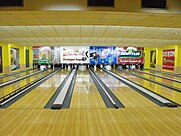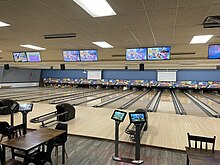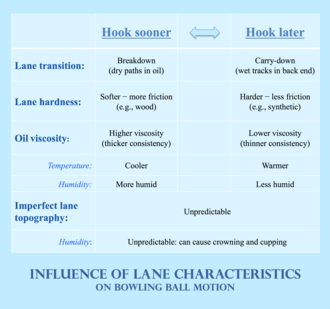
Five-pin bowling is a bowling variant which is played in Canada, where many bowling alleys offer it, either alone or in combination with ten-pin bowling. It was devised around 1909 by Thomas F. Ryan in Toronto, Ontario, at his Toronto Bowling Club, in response to customers who complained that the ten-pin game was too strenuous. He cut five tenpins down to about 75% of their size, and used hand-sized hard rubber balls, thus inventing the original version of five-pin bowling.

A ball bearing is a type of rolling-element bearing that uses balls to maintain the separation between the bearing races.

Ten-pin bowling is a type of bowling in which a bowler rolls a bowling ball down a wood or synthetic lane toward ten pins positioned evenly in four rows in an equilateral triangle. The objective is to knock down all ten pins on the first roll of the ball, or failing that, on the second roll.

Candlepin bowling is a variation of bowling that is played primarily in the Canadian Maritime provinces and the New England region of the United States. It is played with a handheld-sized ball and tall, narrow pins that resemble candles, hence the name.

AMF Bowling is a major operator of bowling centers and major manufacturer of bowling equipment.

Duckpin bowling is a variation of the sport of bowling.

A bowling ball is a hard spherical ball used to knock down bowling pins in the sport of bowling.
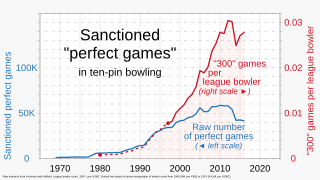
A perfect game is the highest score possible in a game of bowling, achieved by scoring a strike with every throw. In bowling games that use 10 pins, such as ten-pin bowling, candlepin bowling, and duckpin bowling, the highest possible score is 300, achieved by bowling 12 strikes in a row in a traditional single game: one strike in each of the first nine frames, and three more in the tenth frame.
Bowling for Dollars is a television game show on which people could play the sport of bowling to win cash and sometimes prizes based on how well they bowled.
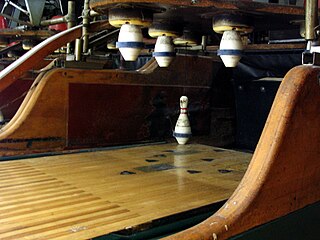
In bowling, a pinsetter or pinspotter is an automated mechanical device that sets bowling pins back in their original positions, returns bowling balls to the front of the alley, and clears fallen pins on the pin deck. Prior to the machine's invention, pinsetters were boys or young men hired at bowling alleys to manually reset pins and returned balls to the player. The first mechanical pinsetter was invented by Gottfried (Fred) Schmidt, who sold the patent in 1941 to AMF. Pinsetting machines have largely done away with pinsetting as a manual profession, although a small number of bowling alleys still uses human pinsetters. While humans usually no longer set the pins, a pinchaser is often stationed near the equipment to ensure it is clean and working properly, and to clear minor jams.

Bowling pins are the target of the bowling ball in various bowling games including tenpins, five-pins, duckpins and candlepins.
In the sport of ten-pin bowling, there are many different ways in which to deliver the bowling ball in order to advance it toward the pins in an accurate and powerful manner. Generally, there are three basic forms of 10-pin bowling. The most basic form is known as stroking, which is the most classic form. The most powerful form is known as cranking, which imparts great leverage and maximum rotation on the ball, but sacrifices accuracy. In between the two is the domain of the tweener, who has characteristics of both, but does not truly fit into either category. A well-known variant of "tweening" is the power stroker.

In bowling, a strike means that all of the pins have been knocked down on the first ball roll of a frame. On a bowling scoresheet, a strike is marked by an "X".

An automatic scorer is the computerized scoring system to keep track of scoring in ten-pin bowling. It was introduced en masse in bowling alleys in the 1970s and combined with mechanical pinsetters to detect overturned pins.

Nine-pin bowling is a bowling game played primarily in Europe. European championships are held each year. In Europe overall, there are some 130,000 players. Nine-pin bowling lanes are mostly found in Austria, Czech Republic, Slovakia, Belgium, Germany, Luxembourg, the Netherlands, Estonia, Switzerland, Serbia, Slovenia, Croatia, Poland, North Macedonia, Hungary, Brazil and Liechtenstein.
Brunswick Bowling & Billiards was the business segment of Brunswick Corporation that historically encompassed the following three divisions:

A hook in ten-pin bowling is a ball that rolls in a curving pattern. The purpose of the hook is to give the ball a better angle at the 1-3 pocket (right-handers) or 1-2 pocket (left-handers.) to achieve a strike. When a ball is rolled straight, hitting the pocket must be precise. By hooking the ball, the ball will hit the pins with more force, producing better carry - especially on the 5-pin during a strike ball. Straight roll - even when it hits the pocket, will tend to leave a tap such as the 5-pin on a light hit, or the 10-pin if the ball was just slightly right of center pocket or with inadequate entry angle. A hook ball can achieve strikes with less precise hits.

Bowling is a target sport and recreational activity in which a player rolls a ball toward pins or another target. The term bowling usually refers to pin bowling, though in the United Kingdom and Commonwealth countries, bowling could also refer to target bowling, such as lawn bowls.
Sport Bowling is any form of ten pin bowling that uses patterns of lane oil to reduce the effectiveness of modern bowling balls. It was created by the United States Bowling Congress, the governing body of the sport of ten-pin bowling, to offer players the opportunity to bowl on exactly the same lane conditions and oil patterns that professional bowlers face while on the PBA Tour. Sport Bowling originally referred to leagues, known as PBA Experience Leagues, which are offered in conjunction with the Professional Bowlers Association. However, the term is now used to refer to any bowling event which incorporates a "sport shot" or oil pattern.

